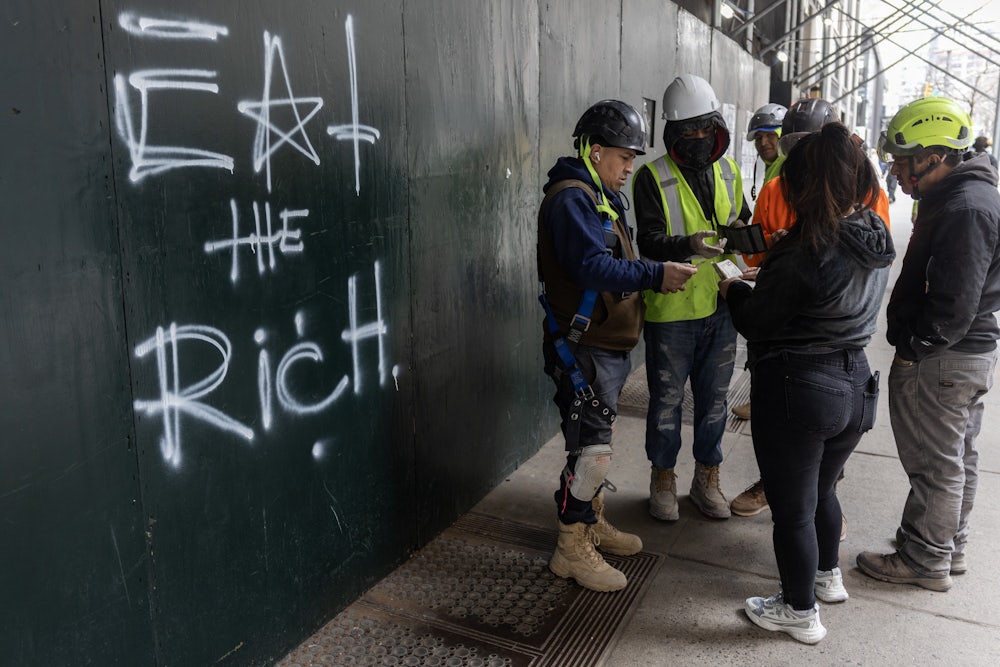America has a housing affordability crisis. Ezra Klein and Derek Thompson’s Abundance, Yoni Appelbaum’s Stuck, and Mark Dunkelman’s Why Nothing Works argue to varying degrees that land-use restrictions, mostly at the local level, are what created this problem and that easing them will solve it. Build more housing, and it will become more affordable.
Last week I argued that there are sound reasons for local communities to exert some control over their neighborhoods—reasons that the new supply-side liberals are reluctant to acknowledge. Protecting the environment, scaling building size to limit opportunities for crime, and preserving architecture of historical significance are all legitimate goals. People should have some power to make their communities livable, because if your community doesn’t do that, it’s doubtful outside forces will—either commercial or governmental.
I don’t disagree that these defensible goals often act as a smokescreen for indefensible goals—such as the exclusion of lower-income people, or the elimination of racial or ethnic diversity. It happens often enough that supply-side liberals are right to call for greater regulatory flexibility, mostly at the local level, to make it easier to build stuff, and not just housing. We need to make it easier to build all sorts of things, including (to cite a central example in Abundance) a bullet train from Los Angeles to San Francisco.
My main problem with supply-side liberalism isn’t what it contains, but what it omits. To address the housing shortage, to build vital infrastructure, and to address all sorts of other problems, judiciously targeted deregulation will be nowhere near sufficient. We also need to address the demand-side problem of distribution.
At the start of the Great Depression John Maynard Keynes published a famous essay titled “Economic Possibilities for Our Grandchildren,” in which he argued that their future would be brighter. He was correct: The Depression ended, the global war that followed defeated fascism, and the West prospered. But Keynes overstated his case. In the essay, he wrote that “the struggle for subsistence” would end and “the economic problem” would disappear. Keynes predicted correctly the creation of stupendous wealth that he wouldn’t live to see. (He died in 1946.) But he was quite wrong to presume that this wealth would be distributed humanely over the long term. Just look around. It isn’t.
Klein and Thompson almost certainly have read Keynes’s essay. If they haven’t, I presume they’ve at least seen the 2008 Pixar cartoon Wall-E, which turns Keynes’s conceit into a sort of sunny dystopia. Yet they begin their book with a description of a futuristic world that’s kind of like—well, Wall-E, minus the grim externalities (a ruined planet, people too fat to walk, etc.). In Keynes’s essay and in Wall-E, everybody’s economic needs are met because the fruits of economic success are shared by all.
Will that happen? I hope so. But it won’t happen by itself, and we certainly can’t get there by tinkering with zoning variances. The government must reverse the past half-century’s trend toward ever-growing wealth and income inequality. Abundance alone won’t cut it. Boosting wages, increasing worker power, and generally restoring the middle class to meaningful participation in America’s economy are much more necessary. Otherwise we’ll just make Elon Musk’s grandchildren richer.
I don’t doubt that the authors of all three books favor these liberal goals; just not enough to give them much ink. Granted, it could be worse. The “It’s Too Hard to Build Stuff” argument, which has been around for decades, used to place heavy blame on the cost of union labor. There have been a few instances (for example, the 1975 New York City financial crisis) when that was even true! But in recent memory that hasn’t been the case, and I’m pleased to report that these books (mostly) eschew union-bashing. Klein and Thompson point out that it costs twice as much to build a kilometer of rail in the United States as it does in Japan or Canada, and that union density is much higher in the latter two countries. Consequently, they argue, unions can’t logically be the problem. (A few pages later they quote an affordable housing consultant griping about having to pay prevailing wage, which usually means union scale, but never mind.) Still, not talking much about unions isn’t good enough. The authors of these books ought to consider unions part of the solution to housing affordability. Boost wages, and people can buy houses.
This blind spot about stagnating wages is pretty glaring. Klein and Thompson cite the economist Ed Glaeser’s finding that prior to the 1980s, wages in New York City were unusually high compared to the cost of living, meaning people stood to benefit if they moved there. After 2000, though, moving to New York City meant taking “an effective pay cut. That’s not because paychecks have shrunk but because housing costs have risen.” True enough, but another reason housing got less affordable—in New York and elsewhere—was that real wages failed to rise for all but the wealthiest. In a thriving economy, incomes are supposed to rise alongside housing prices, and for everybody, not just the rich.
The long-term decline in geographic mobility within the United States is a theme in all three books, and in Appelbaum’s Stuck it’s the central topic. A thriving economy requires that people move to where economic opportunity is greatest—“Go West, young man,” as Horace Greeley said. Alarmingly, there’s far less job-related migration among today’s young men and women (unless they’re affluent) than in the past. To the limited extent working-class people do migrate, it’s away from economic opportunity, because when you have little prospect of increasing your wage significantly you may decide to live someplace where housing is cheaper.
I published an article about this problem a dozen years ago (“Stay Put, Young Man,” Washington Monthly), and I reported that, yes, among the reasons for this harmful economic trend was overly restrictive zoning. But the underlying problem was income inequality. Citing pioneering work in this area by Harvard’s Daniel Shoag and the University of Chicago’s Peter Ganong, I pointed out that working-class people had seen their share of state per capita income growth shrink from 88 percent in 1940 to 36 percent in 2010. Opportunity dried up for America’s working-class majority, putting places with brisk economic growth out of reach for all but the professional class, who could afford to pay more for housing.
Shoag and Ganong have since concluded that zoning restrictions drive growing economic inequality between regions (which in turn drives the nation’s red state–blue state divide). But ask yourself why blue states are able to thrive economically without welcoming in-migration from the working class. It’s because the working class has, to an alarming degree, been dealt out of the United States economy. A much-cited recent study by Moody’s Analytics found that the top 10 percent in the U.S. income distribution (i.e., households earning $250,000 or more) now account for 49.7 percent of all consumer spending and about one-third of gross domestic product.
The more alarming reality isn’t that high housing costs keep the working class out of America’s boomtowns; it’s that these boomtowns don’t have to care. They don’t require much working-class labor, and they don’t require much working-class consumer spending. That diminishment of economic power, tantamount to invisibility, isn’t a housing problem. It’s an inequality problem, and a humanity problem.
Reducing zoning restrictions can help, but not enough. Indeed, in the cities where the affluent are most determined to live, building more housing may serve to increase demand, much as Robert Moses’s expressways, rather than ease traffic congestion, drew additional motorists onto New York City streets. I’ve suggested elsewhere that something like this may be happening in Washington, D.C., which during the past quarter-century increased the number of its housing units by an astonishing one-third, yet saw median monthly rent rise even faster—by one-half.
Housing for low-income people is especially unlikely to become more affordable through market forces. If there’s a supply-side liberal paradise, it’s Houston, which has no zoning at all (though it does have some land restrictions). Klein and Thompson report that Houston has “the lowest homelessness rate of any major U.S. city,” and they cite low building costs as the reason. But a 2023 Governing magazine piece by Alan Greenblatt pointed out that Houston also had no zoning back in 2011, when “Space City” boasted the sixth-largest homeless population in the United States, prompting the department of Housing and Urban Development to place Houston on a watch list. Greenblatt attributed the city’s turnaround to collaboration with various government and nonprofit entities (including HUD), a large pile of Covid-19 stimulus cash, and a more than twentyfold increase in police citations issued at homeless encampments.
Houston’s lack of zoning creates plenty of problems. Between 1930 and 1978, 82 percent of the city’s trash got dumped in Black neighborhoods, even though Blacks represented only 25 percent of the population. The neighborhoods had no power to stop it. A 2025 report by the nonprofit newsroom Houston Landing said this problem persists and that because of Houston’s insufficient local housing subsidies, affordable housing was more readily available in Boston, which is routinely ranked among the top 10 most expensive housing markets in the country.
“There is pressure among liberals,” Klein and Thompson write, “to focus only on the sins of the MAGA right.” Yes, at the moment that does seem to be kind of an emergency (and not just for liberals). “But this misses the contributions that liberal governance made to the rise of Trumpism.”
Sorry, I’m not buying it. All three of these books were written before the election; their argument would be more compelling had Kamala Harris won. A Harris presidency would have created more space for a conversation about small tweaks to liberal orthodoxies. Trump’s victory doesn’t leave us that luxury.
If Democrats are to win back the working-class majority necessary to regain the White House, they’ll need to talk about how a more activist government can address demand-side problems experienced by the proletariat. Back during the 1988 election, Michael Dukakis was judged an out-of-touch technocrat in part because he’d once taken to the beach a book supposedly titled Swedish Land-Use Planning. The supply-side liberals want us to take to the beach a book that might as well be titled American Land-Use Planning. No thank you. I won’t walk that dark road again.










